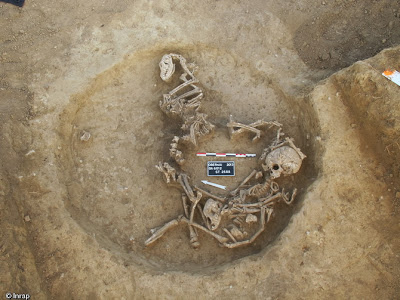 |
| Deliberately distorted skull unearthed in a necropolis of the Late Empire in Obernai (Bas-Rhin), 2013 [Credit: © Denis Gliksman, Inrap] |
Around 6900 years ago: a Neolithic necropolis
In the south-eastern part of the excavated area, the archaeologists uncovered a funerary sector containing around twenty graves. The oldest of them date from 4900 to 4750 BC. Another sector yielded around fifteen additional Neolithic graves. Most of the deceased were adorned with pendants and bracelets composed of small limestone or mother-of-pearl beads. One of them was wearing two stone ring-disks.
 |
| Neolithic burial unearthed at Obernai (Bas-Rhin), 2013 [Credit: © Denis Gliksman, Inrap] |
2160 years ago: a Gallic farm
To the north of the site, the remains of a Gallic farm were found. It is composed of a 8000 m2 enclosure with an unusual plan; it has two doors built into its corners, one of which is covered with a monumental porch. Inside the enclosure, there are building remains, storage pits and many artefacts from the Final La Tene period (150 to 130 BC). These artefacts (fibulae, glass ornaments, pottery, amphorae, coins, etc.) show the importance of this farm and the wealth of its owner.
 |
| Two children and several dogs at the bottom of a silo, dated between 450 and 350 BCE, Obernai (Bas-Rhin), 2013 [Credit: © Denis Gliksman, Inrap] |
The discovery of human skull fragments, weapons and a few burials of children and animals, across the entire site, suggests a religious context, and perhaps even the presence of a sanctuary. One pit in particular yielded umbo shields with marks made by strikes.
These data and the location of this establishment at the border between Mediomatrici and Rauraque populations make this site one of the most important for this period in Alsace.
Around 1650 years ago: peoples from the East
Archaeologists and physical anthropologists have studied a Merovingian necropolis composed of eighteen graves orientated west-east, following the ritual of the period. Objects were found in four tombs, including three silver earrings. The richest of the deceased was wearing two small gold pins that were holding a piece of clothing or a veil on her chest.
 |
| Roman sandstone column, Obernai (Bas-Rhin), 2013 [Credit: © Clement Feliu, Inrap] |
In addition to the grave goods, the eastern origin of the individuals is shown by the presence of a deformed skull. During the Merovingian period, this practice was first associated with the Huns, the famous ethnic group of central Asia. The intentional deformation required the use of wooden planks or ties that bound the head from a very young age.
The Obernai necropolis is one of the few large groups of discovered in France. It is the first evidence of the presence of an eastern community over a long period of time in Alsace at the end of the Roman Empire.


No comments:
Post a Comment